Dr. Una Fitzpatrick, Ecologist with the National Biodiversity Data Centre, explains why we need to conserve our pollinators, and how you can help.

The staggering value of pollination
Pollination services provided by insects, mainly bees, have been valued at €153 billion a year. With 71 out of the 100 crops that provide 90% of food worldwide being pollinated by bees, we shouldn’t take our pollinators for granted!
In Ireland crops such as apples, strawberries, raspberries, tomatoes, carrots and onions are reliant on insects (mainly bees and hoverflies) for pollination; and without pollinators many of our native plant species would quickly go extinct.
Bees and hoverflies are fascinating insects. It might surprise you to know that only female bees can sting, or that most bees don’t produce honey. In Ireland, only the honeybee makes honey, and it’s just one small component of our bee fauna. We also have 20 species of bumblebee and 80 species of solitary bees, adding up to a total of 101 Irish species. There are 180 species of hoverfly in Ireland
Bumblebees, solitary bees and hoverflies — Ireland’s army of pollinators under threat
Any day now you’ll spot a big queen bumblebee, heralding the true arrival of spring. Bumblebee species are identified by the colour pattern on their thorax and abdomen. We commonly think of black and yellow stripes but there are many other colour patterns to watch out for. The red-tailed bumblebee is entirely jet black with a red tail, and the large carder bee gets the prize for best looking bumblebee with a ginger thorax and pure blond abdomen.
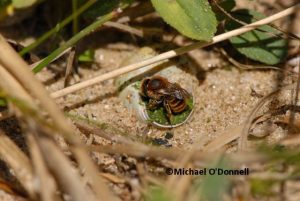
Solitary bees look very different from bumblebees. Some species are small and black like ants with wings, while others have black and yellow striped bodies like wasps. Solitary species nest in various different ways. Leafcutter solitary bees cut circular pieces out of leaves with their teeth and carry them back to line their nests, often in hollowed out twigs or bamboo canes. Mining solitary bees make their nests by digging holes in the ground. One solitary species in Ireland called Osmia aurulenta lives in sand dunes and will only nest in empty snail shells.
Hoverflies come in all shapes and sizes and brighten up almost every habitat across the island. It’s difficult to describe just how intricately linked plants and pollinators are, but there are also amazing linkages between pollinators and other components of our wildlife. There is a hoverfly species (Volucella pellucens) that lays its eggs in the nest of the common wasp where the larvae feed as scavengers on nest debris.
Unfortunately more than half of Ireland’s bee species have undergone substantial declines in their numbers since 1980. A conservation assessment of bees in Ireland produced in 2006(Irish Red List of Irish Bees) found that six species are critically endangered, seven are endangered, 16 are vulnerable and 13 are near threatened. Sadly, two bee species have become extinct in Ireland within the last 80 years. Hoverflies are facing similar threats.
Making a difference… the IPI, and how you can help

The Irish Pollinator Initiative (IPI) was set up to generate data to help drive and direct pollinator conservation in Ireland. The website provides lots of information on pollination, and on Irish pollinators, including species accounts for all 101 Irish bee species and 180 Irish hoverfly species. It also has suggestions of things you can do to help pollinators in your own garden or local park.
One of the main aims of the IPI is to increase the number of people in Ireland who can identify bee and hoverfly species. Having skilled recorders means more knowledge about where the pollinators are, how abundant they are, and what’s happening at local levels. This can then be translated into actions to help protect them. In 2012 the Tawny mining bee was re-found in Ireland, having thought to be extinct here for 87 years!
The key is to have people out there knowing what to look for, and who know where to send the information when they find it.
The IPI is a citizen science initiative, entirely dependent on volunteer recorders. The pollinator recording army currently stands at about 150, but we’re always looking for more recruits. We run identification workshops on bees and hoverflies for both beginners and advanced recorders. There are also keys on the website to help you identify the different species. These range from technical keys to simple picture guides.
Regardless of your current skills there is a pollinator challenge for you!
How you can get involved
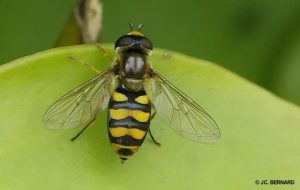
The Bumblebee Monitoring Scheme involves carrying out a fixed route walk once a month and recording the bumblebees that you spot. Generally it takes between 45-60 minutes to do the walk each month and then 5-10 minutes to put the details of what you’ve spotted into our online system. It’s one of the only schemes in Europe tracking what’s happening with wild pollinators across the landscape. It begins in March and we urgently need more volunteers. Beginners are very welcome.
If you prefer something more casual, we have 10 key pollinators beginners can look out for, or perhaps you’d like to help with ‘Rare species watch’ by visiting previously known locations and checking whether two of our most endangered bumblebees still exist there?
You could also try to update the pollinator list for your county. You’d be surprised at how little we know.
If you live in Co. Monaghan, only one bee species has ever been recorded there. You can be the county expert in no time! The Ashy mining bee (Andrena cineraria) is a lovely solitary bee with two distinctive grey bands on its thorax. It hasn’t been recorded in Co. Kerry since 1923. It’s a spring bee that relies on willow flowers for nourishment. It must be in the Kingdom!
If you would like to get involved in the Irish Pollinator Initiative we’d be delighted to hear from you.
Photo Credits: All images provided by the National Biodiversity Data Centre and used with permission, copyright © remains with their respective owners.


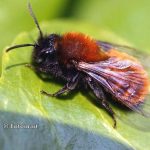

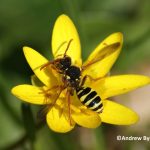
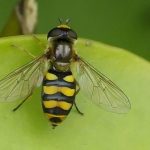

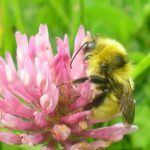
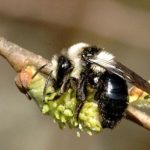








7 comments
Jane Jackson
I was surprised that there is no mention of invasive plant species in the pollinator plan. We have been surveying for 9 different Alien invasive plant species for two years along rivers in Kerry and 3 years before that for just Japanese knotweed along the roads. From what we saw and data collected over 300+ km of rivers and 2000km roads it would appear that these species further impact on the pollinators as the hedgerows and river banks become more and more invaded with these species. Montbretia is particularly worrying as it flowers so late. Our early flowers, so necessary for pollinators are been squeezed out. Check our map at http://www.saveourlaune.org and see the extent of of these invasives along the riverbanks. I look forward to hearing your comments.
Bernadette
I live in Co. Wexford, we have a California Lilac in the back garden and every year the whole plant is alive with bees. If you walk anywhere near all you can hear is the whole plant buzzing, amazing sound. No idea which type of bee though, they’re definitely not honey bees. Almost as wide as they are long and end in a straight line across at end of body rather than a pointy tail, any ideas please and thank you?
Anne reck
We have a ‘swarm of bumblebees’ 60/70 bees, some common yellow striped, but the majority are dark copper coloured, never seen before, complete with what looks like a Queen of the same colour. They are feeding on a flowing shrub attached to the house. Arrived yesterday – left – and are back today. Have never seen a swarm of them ever. Are they a rogue colony or to be welcomed. Anne Reck.
Calvin Jones
Bumblebees are always to be welcomed @Anne, and certainly won’t do any harm. They probably arrived when the shrub began producing nectar for them to feed on, and will keep coming back as long as there’s a food source there for them — helping to pollinate the your garden plants while they’re at it.
Mary Kate (Mikie) Feighan
I would like to help. I walk my dog along the same route every day and spot bees all the time. It’s a 1 mile stretch each way on a country road, somewhat settled. I spotted a what could have been an ashy mining bee struggling in the road. It was coverd in tiny insects (Mites?) that seemed to be eating it alive.
Calvin Jones
Hi Mikie, thanks for the comment.
If you contact the IPI they’ll let you know what you need to do to get involved in any of the various monitoring schemes they run.
Mary Kate (Mikie) Feighan
WIll do, Thank you, Calivn